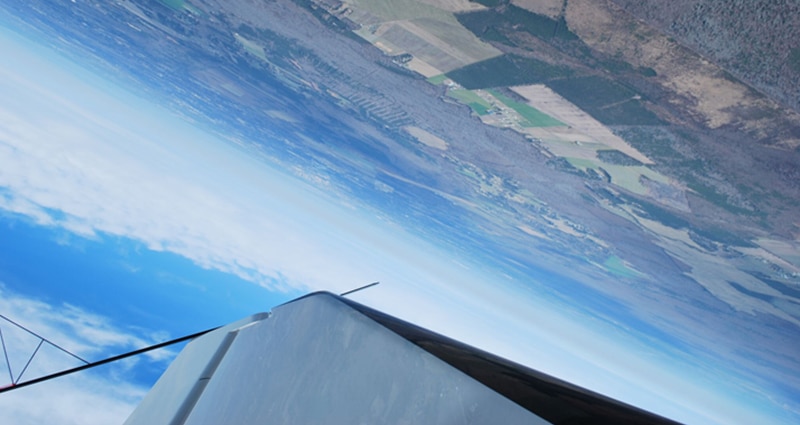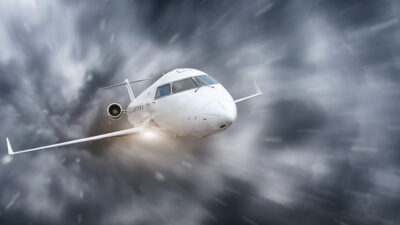Experiential Learning and the Importance of On-Aircraft UPRT Programs

You fly to a simulated abeam position in the landing pattern with your instructor, and you begin to pull power and start your ‘approach to land.’ The instructor imitates a common call from Tower: “945PV, Tower, tighten your turn inside straight-in traffic, mile and a half.” You realize too late that you’ve pulled too much power. As your angle of bank increases and the aircraft stalls, you find yourself nose-low, over-banked and by every professionally-accepted definition ‘upset.’
This is one of many real-world scenarios that are offered in an on-aircraft Upset Prevention and Recovery Training (UPRT) program. Commercial, corporate, military, GA and even student pilots are able to actually experience the progression from normal flight, to an upset condition, to loss of control inflight (LOC-I)—and to learn and practice the processes and procedures to recover— in a safe, methodical and repeatable learning environment.
On-aircraft training is a perfect example of ‘experiential learning’—learning that takes place in the actual environment of the intended learning objectives. The experiential learning model was developed by David Kolb (1984), who first codified the value of learning in an operational environment as ‘authentic’ as possible1. The University of Texas calls this the “concrete experience—engaging directly in the authentic situation”:
“When students are given opportunities to learn in authentic situations…like those provided in internships…clinical experiences…and service-learning projects, the learning becomes significantly more powerful. By engaging in formal, guided, authentic, real-world experiences, individuals:
- Deepen their knowledge through repeatedly acting and then reflecting on this action
- Develop skills through practice and reflection
- Support the construction of new understandings when placed in novel situations
- Extend their learning as they bring their learning back”2
The military, emergency medical technicians, fire fighters, law enforcement and many other communities have realized the value of experiential learning, and have developed training programs that immerse their personnel in increasingly life-like scenarios. This training results directly in lower stress during real-life situations and improved crisis response during a real-life event.
Although on-aircraft UPRT has been available for many years, there has been a lack of available certificated courses of instruction. The recent focus by the FAA, NTSB and ICAO on LOC-I as the leading cause of fatalities in aviation has brought to the forefront the need for professional on-aircraft UPRT3 4. Certificated UPRT courses include a thorough academic phase covering the causes of aircraft upsets, a basic refresher in aerodynamics, case studies and an introduction to the prevention of, and recovery from, upsets and LOC-I. The flight phase consists of several training flights in an all-envelope aircraft and uses a methodical and safe building-block approach that emphasizes learning and skill development. By the end of the course every pilot has experienced numerous aircraft upsets, loss of control scenarios and fully developed spins, and has independently mastered recovering from each situation.
Three often-mentioned challenges to on-aircraft UPRT are: “it’s too expensive,” “you can get all the training you need in a simulator” and “it’s not safe.” Without devoting this entire article to answering these challenges, we can briefly address them. The industry average cost of on-aircraft training is actually less than most simulator programs of similar caliber. The irony is that the higher fidelity the simulator, the more expensive it becomes, and yet it can never quite match the reality of on-aircraft training. The challenge to safety is unfounded; professional on-aircraft UPRT providers conduct training with inherently stable aircraft that are able to maneuver in all attitudes with very wide safety margins.
By its very nature, effective UPRT requires a combination of classroom, on-aircraft training and then simulator training in your actual aircraft. This allows you to transition your new UPRT skills to the aircraft that you fly on a regular basis. On-aircraft UPRT uses the proven advantages of the experiential learning methodology to address LOC-I, the biggest killer in aviation today.
Resources
1 Kolb – ‘Learning Styles’, Saul McLeod, 2013, http://www.simplypsychology.org/learning-kolb.html
2 ‘Experiential Learning – Defined’, University of Texas, 2016, https://facultyinnovate.utexas.edu/teaching/strategies/overview/experiential-learning
3 NTSB’s 2017-2018 Most Wanted Safety Improvements, 2016, https://www.ntsb.gov/safety/mwl/Documents/2017-18/MWL-Brochure2017-18.pdf
4 ICAO SkyTalks Workshop, UPRT Requirements, 2016, http://www.icao.int/Meetings/a39/workshops/Documents/A39%20Workshop%20-%20UPRT.pdf

Prevailance Aerospace is a UPRT provider that has been working with corporate, government, and general aviation pilots to improve safety in the aviation industry. Prevailance Aerospace uses Extra 300 Series Aircraft for training and our pilots are experienced aviation professionals from various military and general aviation backgrounds. We know that successful aviation endeavors are accomplished through an uncompromising commitment to safety, impeccable professionalism, tremendous attention to detail, and constant improvement.
http://www.prevailance.com
© 2024 Prevailance Aerospace. All Rights Reserved.
Next ArticleRelated Posts

Understanding the Challenge of Turbulence-Related Injuries in Business Aviation
The challenge of managing air turbulence in business and private aviation is becoming increasingly evident due to the growing number of turbulence-related incidents affecting aircraft operators across the industry.

Leadership, Management and Safety: Embracing Compliance and Conformance Oversight
Aviation operations, and by default, safety, are based on the idea that regulatory requirements are fundamental to establishing a framework to achieve safe operations.

